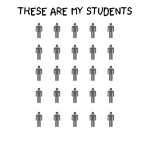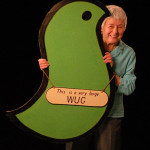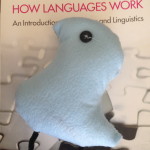This week, my students choose their topics for their research papers. Since I’m teaching a general education writing class which is required of all freshmen, the topic can be literally anything. I have to approve it, but I’ve been pretty flexible. After all, I might learn something interesting! Not to mention reading 25 papers on the same thing is eye-numbingly boring. More »
As the internet’s leading wugologist (is anyone else a wugologist?), I’ve decided to begin collecting the diverse variety of wugs found in the world. After all, wugs come in all shapes, sizes, and colors! More »
I’m not gonna lie, I’m somewhat jealous of #thegiftofdata. This couple tracked their text messages for a whole year of dating and a whole year of marriage, and got some pretty cool word clouds out of it!
A few months ago, Linguistics Club had a arts & crafts night, and most people ended up making cute wugs!! But I forgot to blog about it! More »
In case you haven’t heard, Never Alone is a video game based on Alaskan Native mythology. So many video games are loosely based on Arthurian legends (don’t try to tell me there’s no resemblance between The Master Sword and Excalibur), Western history (there are several franchises dedicated to games about the World Wars), or modern Western life (GTA, anyone?). So I’m pretty excited that we’re getting some new storylines in video games, and these people have an international platform to share their culture and language! I plan to buy it on release day, and hopefully post a review here shortly thereafter! :)
In the meantime, watch the trailer here:
The news coverage of the ebola outbreak is interesting, and probably worth some linguistic analysis at some later point. My impression is that it oscillates between causing and placating panic. One story will decry sanitary conditions in hospitals and demand the borders be closed to West African countries, so everyone panic because we’re all about to die horrible deaths. The next story will emphasize that it’s hard to contract ebola unless you’re handling bodily fluids or eating African fruit bats, so don’t worry everything is going to be okay.
More »
I’m a linguist. At the core of my soul, I believe in descriptive linguistics. A biologist goes out in the world, and describes the anatomy of the plants and animals he collects. He doesn’t say “this shouldn’t exist, because evolution says it shouldn’t!” Likewise, linguists go out in the world and describe the languages they collect. They don’t say “this shouldn’t exist, because the grammar rules says it shouldn’t!” Linguists and biologists alike wonder at all the weird structures they find, and aren’t judgmental about them.
Is there a time and a place for “correct grammar”? Sure, but it’s cultural. It’s not an objective fact. Stephen Fry put it nicely: just like you dress up your attire for special occasions (like job interviews), so do people dress up their language. All the science says that most of the “rules” people are taught in grade school are totally bunk. When I taught Intro to Linguistics last summer, I spent a whole lecture going over why Weird Al’s Word Crimes was totally bunk. Other linguists did so too.
Which is why I feel totally weird and out of place being a prescriptivist teaching “correct” “academic” writing. Sure, I can teach them some common conventions and research skills. But I’ve been asked questions like “Is it Tom and me or Tom and I?” And the real answer is “it depends” or maybe “whichever one is more frequent in your dialect”, but the answer they want to hear is “it’s Tom and me if the phrase is an object and Tom and I if the phrase is a subject, because I and me are case-marked pronouns and English was a historically case-marking language even though we don’t use case anymore except in these pronouns and some people who still use whom“.
I’m finally getting into GitHub, partially thanks to Coursera’s Data Science specialization, which requires it. Anyway, I blogged about my twitter bot, @AllTheLanguages, here and here, and now you can download, fork, watch, star, or whatever it is that kids do on GitHub to code here.
One of the first things many people learn in introductory linguistics classes is that there are about 7,000 languages in the world, plus or minus 1,000, depending on whether or not you’re only counting living languages or dead ones too, and how you divide the line between languages and dialects. Counting languages is difficult, even for professional linguists. But what about for laypeople? Does average Joe even realize how many languages there are in the world? Are linguists doing a good job of educating the public? More »
Counting languages is difficult for several reasons. First, there are still uncontacted tribes who speak undocumented languages, so the number could increase. Second, language endangerment and language death is causing rapid loss of linguistic diversity, such that over 50% of the world’s languages are expected to be extinct by 2100, and there’s a good chance linguists have already missed the opportunity of documenting hundreds, if not thousands, of languages which have already died.
Politics and culture also sometimes make classifying languages and dialects difficult. For example, there are nearly a dozen distinct, yet related, Chinese languages. They’re as different as Spanish, French, and Italian. Yes, they share a common ancestor (just as the Romance languages descended from Latin), but they are no longer mutually intelligible. Mutual intelligibility is the criteria linguists use to determine whether two varieties are a language or a dialect, so under this definition they are different languages. However, the Chinese census counts them as dialects of the same language, in order to portray China as a unified country.
The opposite can happen too. Hindi and Urdu are mutually intelligible. They are dialects of the same language. However, since they’re spoken in different countries, by people who largely use different writing systems and follow different religions, many people consider them to be different languages!
All in all, most linguists agree there’s somewhere in the ballpark of 7,000 languages in the world, and @AllTheLanguages is tweeting about them all!



